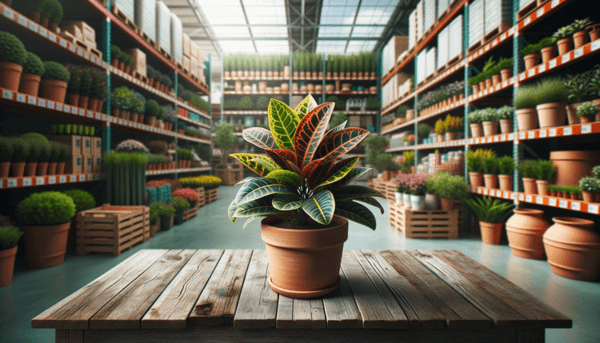
croton
Information for the customer:
- Plant Position: indoor
- Soil Type: well draining , porous , all purpose
- Watering Needs: moderate: anytime between weekly to fortnightly
- Shade Requirements: yes
- Lighting Requirements: less/average light: 25% - 50% of daily sun
- Pet Child Friendly: no
- Air Purifying: yes
- Humidity Needs: high
Helpful Tip:
- Helpful Tip: Provide bright but filtered light; avoid cold drafts
Potting Sizes and Info:
- Maximum Growing Height: 180cm
Additional Facts and Info:
- Scientific Name: Codiaeum variegatum
- Native To: Southeastern Asia, indonesia, india
Extensive Info on the croton:
How do you take care of a Croton?
Location
The Croton likes to be placed in a spot with lots of light. Not all species tolerate bright light well. It is best to place the plant in medium bright light. The Croton prefers a spot next to a window on the west or east. A spot near the south is of course also possible. Make sure that the plant is at least 2 meters away from the window. A spot near the north probably has too little light.
If a Croton gets too little sunlight, the plant will grow long stems. With its long stems, the plant hopes to reach the sunlight. This can be crucial for the plant because the leaves can become too heavy and break off if the stems get too long. Therefore, don’t forget to rotate the Croton! The plant grows towards the sun, so rotating it helps ensure even growth.
Watering
It is important to always keep the soil of the Croton slightly moist. You can check this by inserting your little finger into the soil. Never let the Croton dry out, even in winter. It is best to water the Croton once a week all year round. Adjust the amount of water you give based on the moisture level of the soil.
If the leaves are wilting, it is a sign of overwatering.
When lower leaves are falling off or drying out, it is a sign of under-watering. Keep the soil moist, but water only when the top of the soil is dry to the touch.
Plant nutrition
The Croton can use some extra nutrients from spring to the end of summer. You can provide these nutrients using plant nutrition. We recommend giving plant nutrition once every six weeks. After autumn and in winter, it is better not to give extra nutrients, as plant nutrition during that time can be harmful to the Croton.
Repotting
Repotting the Croton isn't necessary every year. We recommend repotting the plant every 2 years. This gives the plant enough new nutrients and more room for root growth. The best time to repot is in the spring.
Air-purifying
Croton is an air-purifying plant that helps remove toxic VOCs (volatile organic compounds) from the surrounding air.
Is the Croton toxic?
Croton plants are toxic to both humans and animals. The plant emits a milky sap from broken stems that can lead to contact dermatitis in humans. Swallowing the sap may cause ingestion distress with chances of mouth irritation in dogs, cats, and children.
Diseases and peculiarities
If the air is too dry, the Croton can suffer from mealybugs. To prevent mealybugs, it is best to use a plant sprayer once a week. Mealybugs are an infection on plants and can be recognized by infected leaves and a kind of cobwebs. If you come across mealybugs, placing the plant outside with exposure to wind and moisture from outside can help keep the mealybugs away.
Frequently asked questions about the Croton
Why is my Croton drooping?
When the Croton is thirsty, its leaves droop dramatically. After you have watered the plant, it will slowly recover.
Why does my Croton get brown spots or edges on its leaves?
Brown spots on Croton leaves are always caused by incorrect watering. It can be caused by too much or too little water.
Can you propagate a Croton?
Yes, you certainly can. Check out our tips on how to propagate the Croton.